Redemption: Area 51, #10 Read online
Page 2
The city was the surface part of the actual base, most of which was underground.
Her commander had not been as amused and several subsequent Earth probes had been sabotaged or destroyed. Nuclear weapons had been detected on several launched by the Russians, indicating they definitely suspected what was here.
The Americans had also tried to use one of their probes to nuke the base. It had been destroyed at 3 miles altitude.
Nyx moved to a different console and brought up data on the defensive scheme for Cydonia. Even without the master guardian computer, she could control the close-in defense system at the center of the solar panels, especially against a small, STL, human craft. She manually activated the targeting sub-routine. Acquired the spaceship and locked on.
But then she stopped.
The ship was moving upward, breaking orbit.
The ship reached terminal velocity and headed toward Earth.
Nyx went back to her own console. Her fingers moved quickly over the hexagonal keys, entering information, her observations about what had just occurred, the actions of the two human players and what they represented and—
She paused.
What was the point?
She sat back, closing her eyes.
Glanced back at what had been Rover. Typed in some commands and the slurry took form. This go-around a German Shepherd. Data indicated that this breed tended to bond more with one person rather than multiple and was more protective.
She needed a name. Rex, a derivative of an ancient human language term meaning king came to mind. She added that to the programming.
“Rex,” Nyx called out.
The dog trotted over.
It didn’t appear as friendly as Rover. There was something fierce about its coloring, dark eyes and narrower head.
“Come here, boy.” Nyx ran her fingers through his fur. Coarser than Rover’s. She scratched behind one ear and Rex turned his head, pressing against her hand. An appropriate reaction according to the data.
She stopped scratching and put a hand on either side of Rex’s head, peering into its eyes.
And felt nothing. Passive observation.
The other scientists in the crew had called her foolish, pointing out that nanotech had never accurately replicated any living being. She knew they were right. Life contained something no machine, no matter how large or small, could ever possess.
But simulations were all she could do when she wasn’t allowed to perform field experimentation and Nyx’s repeated requests to visit Earth had been flatly denied. All she’d wanted was to zoom in and scoop up a couple of dogs. The truce between Artad and Aspasia forbade it; the truce which the humans had finally managed to shatter.
A simulation was the next best thing.
And not good at all.
Nyx turned away from the nano-dog.
She tapped a code. A light flashed yellow and a warning tone chimed.
She ignored both. With a single long finger she slid a gauge lower.
With a perceptible shift in air pressure, the control center began to vent oxygen. The light went from yellow to red. The tone became insistent. An automated over-ride tried to engage, but she tapped in a command code, stopping it and the tone.
The gauge indicated that the oxygen level was below fifty percent.
Nyx’s breathing became rapid, her lungs desperate for oxygen despite her conscious actions to the contrary.
She glanced at the German Shepherd. It watched her with no visible signs of concern or interest, although the programming cause it to pant for air, even though the nanotechnology didn’t need it.
Tears formed in Nyx’s eyes as once more she tasted this terrible way to die.
At the last second, on the precipice of unconscious and inevitable death, her finger twitched, sliding the control up. The vents closed and oxygen poured in, equalizing pressure.
Nyx slumped in the chair and buried her head in her hands.
BEYOND THE HELIOSPHERE
The Universe is in constant motion. Planets move around stars. Stars, and their attendant solar systems, move inside their galaxies. Galaxies move in the Universe as it constantly expands. It has been doing so since the “Big Bang” over 13.799 billion Earth years ago. Constant motion, constant conflict, constant interactions.
As it travels through space, the Solar System has a natural defense against interstellar cosmic radiation: the heliosphere. The sun emits a constant flow of charged particles, plasma, commonly called solar wind, which travel past all the planets, to a distance three times the orbit of Pluto and its fellow dwarf planets in the Kuiper belt, forming this protective envelope. At that distance is the bow shock of the heliosphere, where the solar wind meets interstellar space, loses energy and ceases.
On 25 August 2012 the first human spacecraft left the heliosphere and officially became ‘interstellar’. As Voyager 1 crossed the boundary, it experienced a forty times increase in galactic radiation.
Voyager 1 was launched on 5 September 1977. It is currently traveling at 11 miles per second. While fast, it isn’t as fast as the Juno probe, which hit 25 miles per second after a ‘slingshot’ maneuver around the Earth before it headed toward Jupiter. Of course, both those speeds are tortoise-like considering the speed of light is 186,000 miles per second.
THE HELIOSPHERE
It takes the sun’s light eight minutes to reach Earth. That distance between Earth and sun is also called an astronomical unit or AU. The AU is then used to determine the parsec, which is exactly 648,000 AU divided by pi or 3.26 light years.
From the sun to Mars is 1.524 AU. Sunlight to Mars averages 12.9 minutes. Between Earth and Mars, light takes another 4 to 22 light-minutes depending on their orbital relationship; at present it took five minutes as they were close.
From the Sun to the edge of the Solar System, the heliosphere, is 100 AU or 17 light-hours. That is not only the speed at which light travels, but all electro-magnetic transmissions, such as radio. The General Theory of Relativity posits it is also the speed of gravitational waves.
Thus, when the massive alien spaceship came out of FTLT—faster-than-light-transit—in interstellar space in the bow shock of the heliosphere, no one on Earth, or Mars for that matter, could possibly know. In Earth time it arrived just a day after the array on Mars was destroyed and as Turcotte and his comrades were entering Earth’s atmosphere, unaware there was a new visitor to the Solar System.
They would, of course, eventually become aware.
A VISITOR
AREA 51
The spacecraft Mike Turcotte piloted back to Earth was saucer shaped with a bulge in the forward center and two large pods in the rear, which housed the STL engines. It was dull gray and the surface was scarred and battered, including his patch job of red material on the upper right deck. It was designed for two people, with seats inside depressions for pilot and co-pilot next to each other in the forward center facing the outside displays and controls. There were two regeneration tubes in the rear of the crew compartment, leaving barely enough room for the others he’d saved on Mars to crowd in.
It took a day’s journey from Mars, at a blistering speed of 1,750 miles per second, which Kincaid the NASA specialist, who was part of the group, had gleefully calculated, to get back to Earth. Turcotte landed on a pad next to Groom Mountain. Huge hangar doors cut into the mountainside had been blasted open, revealing bays where classified aircraft had been hidden over the decades, including Airlia atmospheric craft called Bouncers.
A hatch on top of the craft opened and Turcotte climbed out. He moved slowly, climbing down the side of the aircraft to the pitted concrete. Of average height, he was solidly built with dark skin, the legacy of a Canuck/Native American intermingling. He wore a grey coverall stained with sweat and hadn’t shaved in several days. His short, dark hair was uncombed and disheveled, the percentage of gray a bit more than it had been on the trip in the other direction.
He was followed by the other survivors of the Mars m
ission: Yakov, Quinn, Kincaid and Leahy. Once on the ground they automatically turned to him.
Turcotte enjoyed the warmth of the late afternoon desert sun on his skin; something he hadn’t expected to experience again. He noted that the Area 51 complex appeared deserted. The doors to Hanger One in the side of Groom Mountain were drooping on their hinges. The long runway from which numerous experimental aircraft had taken their first flight had thin strands of sand blown over it. There were a cluster of airplane hangars and other buildings near the control tower a half-mile away.
Duty called.
Turcotte faced the others. “We don’t have a mothership capable of FTL travel so we can’t help other worlds,” he began, referring to the recent disclosure by one of their team, Kelly Reynolds, that humans had been seeded on Earth, and a dozen other planets, as cannon fodder for an interstellar war the Airlia were engaged in against a species called the Swarm, also known as the Ancient Enemy. “We don’t have the Grail or master guardian either. Both went down with Lisa Duncan on Mars when she destroyed the array.
“We are free of the aliens, though. Which was her goal. And ours. And it must remain our goal. We know there are Airlia artifacts still here on Earth, hidden away. Some discovered by governments and kept secret, some not found. And we know for certain there is life out among the stars. The Airlia. The Swarm. Neither of which wish us well. And undoubtedly other life forms.” He paused, uncertain how to proceed given he’d accomplished his sole objective of defeating the Airlia.
“What about telling the world the truth?” Yakov asked. The burly, bearded, Russian had been a member of Section IV, the Russian version of the U.S.’s Majestic-12, formed to secretly monitor alien activity on Earth.
Turcotte, former US Special Operations who’d been brought in to provide security at Area 51 at the very beginning of all of this, had put aside his differences with the Russian and they’d joined forces to battle the Airlia, recognizing the greater threat to the planet.
Turcotte considered Yakov’s proposal. “Could the world handle it?”
When no one responded he continued. “If you had asked me that question yesterday, I would have said the truth must be told. But now? What good would it do? The world knows there are aliens. That they threaten us. Telling people that we were ‘grown’ to serve as soldiers for the Airlia will destroy all the faiths. People will also know we destroyed their chance at immortality with the destruction of the Grail.
“Duncan’s people developed enough to overthrow the Airlia on their planet without the aid of the Grail. We did the same here. And beat the Swarm scout ships. Who knows what the future holds for mankind if we are uncorrupted by alien influences?” He looked at Professor Leahy. “Tesla invented his weapon on his own. Our future is ours.”
Leahy was an older, tall woman with shoulder length gray hair. An expert on Nikola Tesla, she’d rigged a version of a ‘ray gun’ he’d invented and used it to shoot down a Swarm scout ship in 1908. The craft exploded just above Tunguska, causing widespread devastation in the Siberian wilderness. Her modern version had helped them during the Mars mission.
Turcotte continued, picking his words. “The original charter of Area 51 was a wise one. It worked until Majestic was corrupted by the Temiltepac guardian. I say we pick up that charter. We join it with that of the Watchers.” He was referring to a secret, small group of humans founded by Lisa and Duncan and her mate, who’d been observing the aliens and their minions ever since the destruction of Atlantis.
Turcotte held out his hand, palm up. “Are you with me?”
The others reached forward and placed their hands on top of his.
“We know the aliens were here,” Turcotte said. “We know they changed human history. Their presence and their technology almost destroyed the human race many times in the past and will in the future if we do not prevent it. We must guard the truth and the planet. We will watch. And we will act when we need to.”
They remained silent for a few moments, but movement in the distance caught Yakov’s eye.
“We will have to act sooner than you thought,” Yakov said, indicating a convoy of wheeled military vehicles coming out of a large hangar next to the runway.
LOS ANGELES INTERNATIONAL AIRPORT, CA
“Could you tell those people to put out their cigars?” The old woman hidden under the wide-brimmed straw hat indicated a cluster of businessmen on the other side of a thick glass partition. She had not bothered looking up from the screen of an eight-inch square piece of flexible plastic covered with complex flow-charts. The flexpad was actually a terminal to her private world-wide-web, Ethos, completely separate and secure from any other network, deeper and more secure than the blackest of the ‘dark web”. The flexpad was transparent from her side, other than what was on it, but opaque from the other.
Her finger was moving, tracing various lines, backtracking, sliding up and down, at a quick pace. She was examining possibilities and projections for the future. The lines on the screen pulsed, as if alive, indicating everything was in constant flux. Various juncture points glowed with different colors, a coding that Mrs. Parrish was quite familiar with. She tapped on one and more information about that decision point was displayed.
The concierge was used to dealing with the spoiled rich in the exclusive terminal at LAX for those who flew private. “Madam, they, like you, have paid a generous fee for use of this terminal. The smoking lounge is separate, as you can see, and has powerful exhaust fans and we were assured by the architect that—“
“I can smell it,” she interrupted.
The concierge wrinkled his nose. “Madam, everyone is excited about recent events. I believe the men are celebrating West Coast Secession from the United States and I am afraid—“
“I don’t care about your fear, I care about your actions,” she said, her finger pausing. “I don’t care what they are celebrating.” She lifted her head so he could see her face. “Do it.”
He blanched. “Mrs. Parrish. Of course. Immediately.” He scurried to the smoking lounge, the heavy, clear doors quickly sliding open and shut, designed to minimize any seepage.
Mrs. Parrish didn’t bother to watch the brief burst of outrage from the men that was quickly squashed by the mention of her name. The fools. They were celebrating what she’d just made happen and had no clue what it really meant.
Confusion and misdirection.
She shifted her attention as her pilot approached.
“I apologize, Mrs. Parrish,” he said. “It was the indicator light, as I suspected, not the equipment.”
Mrs. Parrish stood. “Never apologize for doing your job correctly. A lesser pilot would have assumed what they suspected was true, ignored the warning, and not inconvenienced me with this delay. And most likely all would have been well, as it was indeed just the light. But, there is a reason for the warning light, isn’t there?”
“Yes, Ma’am.”
“You followed proper procedure, correct?”
“Yes, Ma’am.”
“Good. Let’s be on our way.”
Two bodyguards who’d been inconspicuous, joined them from strategic positions in the room, one taking the lead, the other trailing.
The pilot walked at Mrs. Parrish’s side to her private jet. He did not offer a hand as she carefully took the stairs. He’d tried that once. He did wait until she was safely in her seat before entering the cockpit and joining his co-pilot. The bodyguards took jump seats on the bulkhead behind the cockpit. A door shut between them and the rest of the cabin, where Mrs. Parrish was seated.
Mrs. Parrish was a woman who’d never been pretty, even in her prime. She was brilliant, which for some, particularly her husband, easily trumps looks. She was short, 5’4”, stocky, and wore a frumpy ankle length smock covering a blocky body. The wide-brimmed straw hat went with her everywhere, protection against the sun and perhaps more. Her face was lined with wrinkles, almost hatchet-shaped and her nose obviously too big, confirming she’d never had any expert
work done on her face, because one would certainly start with that nose?
As the jet punched into the sky, Mrs. Parrish called out: “Maria?”
Her personal assistant came from the rear galley. An old Labrador retriever, black, with a gray speckled snout, was next to her. A highly trained guide dog, it wasn’t needed by Maria in the confines of the plane, but it never left her side.
Maria was Hispanic, middle-aged, slender, dark-skinned, with thick, black hair woven into an intricate braid to the small of her back. She wore, wraparound dark glasses. She had a flexpad hanging from her neck on a silver necklace. There was an earpiece in one ear, tied into Ethos, through which she was receiving a steady stream of updates from the company headquarters. It was narrated by a computer voice, speaking in an even tone, just above a whisper, allowing Maria to hear what was around her, while at the same time processing the information flow.
“UNAOC?” Mrs. Parrish asked, referring to the United Nations Alien Oversight Committee.
Maria responded by lifting the flexpad, the necklace locking it in place, chest high. Her fingers were light on the surface as she typed. The surface of her pad was unique, specifically designed to overcome her disability. The display was tactile, a refreshable braille surface consisting of thousands of tiny, round-tipped pins. Not only could she read the braille, she could feel images and even interpret colors based on the slight change of pressure the pins exerted.
“On hold, Ma’am.” In response to Maria’s typed command, a large screen folded down from the ceiling.

 Independence Day
Independence Day Invasion
Invasion Chasing the Ghost
Chasing the Ghost Hallows Eve
Hallows Eve New York Minute
New York Minute Valentines Day
Valentines Day Eyes of the Hammer
Eyes of the Hammer Walk on the Wild Side
Walk on the Wild Side D-Day
D-Day Lawyers, Guns and Money
Lawyers, Guns and Money Z: The Final Countdown
Z: The Final Countdown Redemption: Area 51, #10
Redemption: Area 51, #10 Time Patrol
Time Patrol Interstellar
Interstellar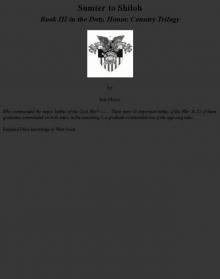 Sumter to Shiloh
Sumter to Shiloh Dragon Sim-13
Dragon Sim-13 The Line
The Line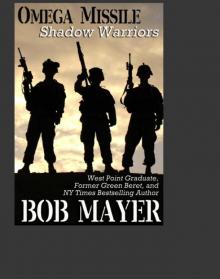 Omega Missile (Shadow Warriors)
Omega Missile (Shadow Warriors) The Rift
The Rift The Jefferson Allegiance
The Jefferson Allegiance Project Aura
Project Aura Synbat
Synbat Ides of March (Time Patrol)
Ides of March (Time Patrol) Nightstalkers a5-10
Nightstalkers a5-10 Lost Girls tc-2
Lost Girls tc-2 West Point to Mexico
West Point to Mexico Mexico to Sumter
Mexico to Sumter Area 51_Invasion
Area 51_Invasion Eternity Base
Eternity Base The Line bo-2
The Line bo-2 Atlantis Gate
Atlantis Gate I, Judas
I, Judas Area 51_Redemption
Area 51_Redemption Bodyguard of Lies
Bodyguard of Lies Cut Out
Cut Out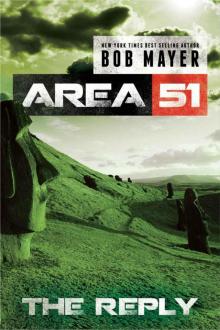 The Reply (Area 51 Series Book 2)
The Reply (Area 51 Series Book 2) Synbat tgb-3
Synbat tgb-3 The Book of Truths a5tn-2
The Book of Truths a5tn-2 Eyes of the Hammer (The Green Beret Series)
Eyes of the Hammer (The Green Beret Series)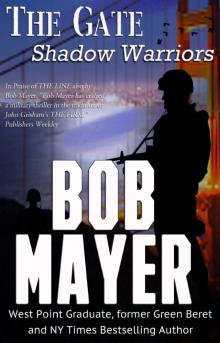 The Gate
The Gate The Gate bo-1
The Gate bo-1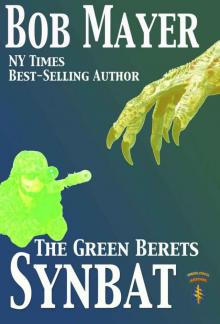 Synbat v5
Synbat v5 Omega Sanction
Omega Sanction Z
Z Chasing the Son
Chasing the Son Nightstalkers
Nightstalkers The Book of Truths
The Book of Truths Dragon Sim-13 tgb-2
Dragon Sim-13 tgb-2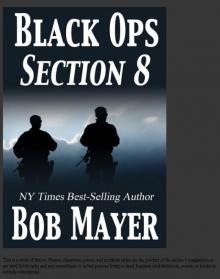 Section 8
Section 8 Chasing the Ghost v5
Chasing the Ghost v5 Psychic Warrior
Psychic Warrior Chasing the Lost
Chasing the Lost The Kennedy Endeavor (Presidential Series Book 2)
The Kennedy Endeavor (Presidential Series Book 2)